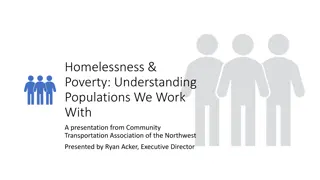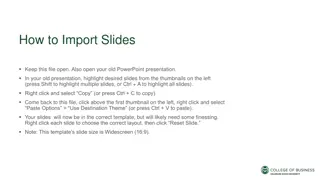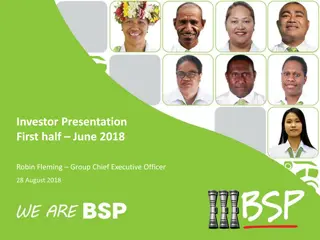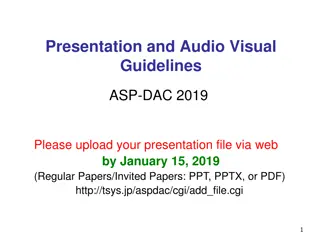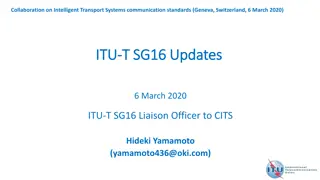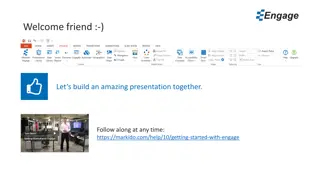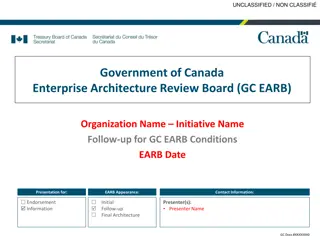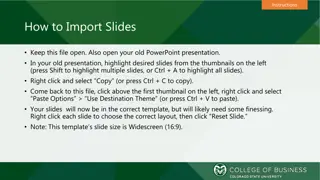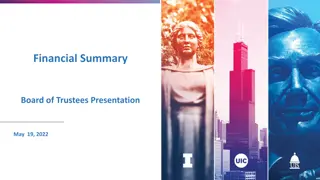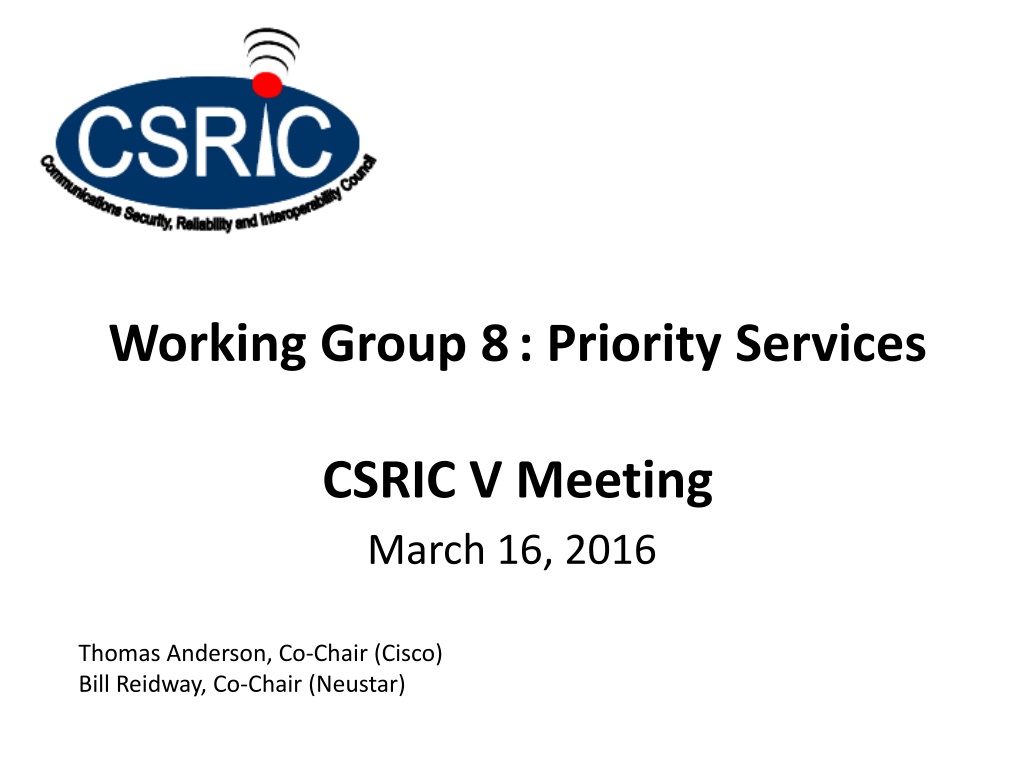
CSRIC V WG8 Priority Services Program Overview
Explore the mission of the CSRIC V Working Group 8, focusing on advancing priority services through modern technologies and protocols. Learn about the objectives, deliverables, member list, and status updates of the group's initiatives, aiming to enhance communication reliability in critical situations.
Download Presentation

Please find below an Image/Link to download the presentation.
The content on the website is provided AS IS for your information and personal use only. It may not be sold, licensed, or shared on other websites without obtaining consent from the author. If you encounter any issues during the download, it is possible that the publisher has removed the file from their server.
You are allowed to download the files provided on this website for personal or commercial use, subject to the condition that they are used lawfully. All files are the property of their respective owners.
The content on the website is provided AS IS for your information and personal use only. It may not be sold, licensed, or shared on other websites without obtaining consent from the author.
E N D
Presentation Transcript
Working Group 8: Priority Services CSRIC V Meeting March 16, 2016 Thomas Anderson, Co-Chair (Cisco) Bill Reidway, Co-Chair (Neustar)
WG8 Objectives Working Group Description: WG 8 will assess how priority services programs can take advantage of packet-based technologies and recommend protocols that can be used to ensure priority communications upon retirement of TDM. Deliverables: Define and describe the services that should be included in a new next- generation government priority communications platform. 2
WG8 Deliverables List of use cases and support requirements for when priority access is needed due to network congestion or outages Proof-of-Concept / Architecture Requirements white paper, including: How a next-gen Priority Services framework will address authentication, authorization, privacy, eligibility and security. Evaluation of barriers, both administrative and technical (E.g. How to authenticate and what is the appropriate access control mechanism?) Definition of capabilities for domestic and international access and termination Description of potential ordering, billing and provisioning options for the next generation priority service. Outline of network management best practices needed to enable priority services for NS/EP personnel. 3
WG8 Members Thomas Anderson (Co-chair / Cisco) Bill Reidway (Co-chair / Neustar) Greg Schumacher (Sprint) Natalie Baker (Intrado) Chris Oberg (Verizon) Zachary Johnson (DHS) Brian Allen (TWC) Jason Weil (TWC) John Brzozowski (Comcast) Lynette Van Someren (Comcast) Martin Dolly (AT&T/ATIS) Keylor Eng (AT&T) Bill Mertka (Motorola/ATIS) Stacy Hartment (CenturyLink) Kathryn Condello (CenturyLink) Matt Tooley (NCTA) Kevin Beaudry (Charter) Ingrid Caples (HHS) Joanne Sechrest (DHS) Rob Dew (DHS) Tim Perrier (FCC Liaison) Ken Burnley (FCC Liaison) 4
WG8 Status Update CSRIC V WG 8 Special Sessions CSRIC V WG 8 Regular Meetings 10/29/15: Co-chairs announced during regular CSRIC meeting 11/10/15: Initial Kick-off meeting held 11/18/15: Co-chair briefing held with RADM Simpson (Chief of FCC PSHSB) regarding scope and direction Regular Meetings: 02/05/16 12/04/15 02/19/16 01/04/16: In person WG briefing held with RADM Simpson 12/10/15 03/04/16 01/13/16: Conference Call briefing held with DHS Office of Emergency Communications 01/8/16 01/22/16 03/14/16: FCC TAC NG Internet Working Group Briefing 03/15/16: Face-to-face Working Session 05/22/16: CSRIC WG Briefing to Priority Services Users UPCOMING: FirstNet Briefing CSRIC V WG 8 Report Schedule End Q1 2016: Use Case / Scope document complete June 2016: Submission of Draft WG8 Report 1 Sept 2016: Submission of Draft WG8 Report 2 December 2016: Submission of Final WG8 1 Report March 2017: Submission of Final WG8 Report 2 5
Priority Service Framework Network Factors Identifying potential weak links in QoS, security, & resiliency Assume managed / unmanaged & public / private hybrid scenarios 6
Priority Service Framework User Factors: Establishing a common authentication framework Accommodating dynamic priority assignment Domestic / International ingress Provisioning, ordering, billing Geography Back Office Identity Priority Network Factors Identifying potential weak links in QoS, security, & resiliency Assume managed / unmanaged & public / private hybrid scenarios 7
Priority Service Framework Application Factors Assuming a multimedia approach Prioritization within authorized users across services Messaging / Social Media IoT Video Voice User Factors: Establishing a common authentication framework Accommodating dynamic priority assignment Domestic / International ingress Provisioning, ordering, billing Geography Back Office Identity Priority Network Factors Identifying potential weak links in QoS, security, & resiliency Assume managed / unmanaged & public / private hybrid scenarios 8
Next Steps Continue regular and ad-hoc WG meetings & external briefings Finalize internal use case / scope section 03/31/16 Develop draft content for 06/30/16 First Report Provide periodic status updates to Steering Committee and Council 9






